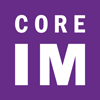Core IM
Though therapeutic radiation is a common intervention among cancer patients, with up to 50% of all cancer patients receiving some form of radiation therapy, understanding of radiation therapy among generalists remains an unmet need. Medical school curricula commonly include the basic underlying mechanisms of chemotherapy, but the physiology and role of radiation therapy is often unaddressed (or remains a limited/optional module). This can pose a challenge in the triage and management of post-radiation symptoms, for which patients often present to their primary care providers rather than their radiation oncologists. This issue is commonly encountered in, but not limited to, concerns regarding potential radiation-associated pneumonitis, immunosuppression, and cytopenias. Furthermore, without a physiologic understanding of radiation therapy, there can be misconceptions among both patients and providers alike. With an improved understanding of the physiology, modalities, and role of radiation therapy in the treatment of cancer, internists and other front-line providers can aid in the management of possible post-radiation effects, while providing reassurance to patients.
Join the Core IM team as they explore Radiation Oncology Side Effects: 5 Pearls Segment.
First, listen to the podcast. After listening, ACP members can take the CME/MOC quiz for free.
CME/MOC:
Up to 0.5
AMA PRA Category 1 Credits ™ and MOC Points
Expires May 30, 2026
active
Cost:
Free to Members
Format:
Podcasts and Audio Content
Product:
Core IM
Welcome to Core IM, a virtual medical community! Core IM strives to empower its colleagues of all levels and backgrounds with clinically applicable information as well as inspire curiosity and critical thinking. Core IM promotes its mission through podcasts and other multimodal dialogues. ACP has teamed up with Core IM to offer continuing medical education, available exclusively to ACP members by completing the CME/MOC quiz.

Systemic effects of radiation
- While radiation’s effects are mostly localized to the target tissues and those nearby, there are some general effects that we should know about.
- (1) Fatigue:
- It’s a mystery why this happens (possibly cytokine-related)
- It’s by far the most common and most persistent effect of radiation.
- It can be very mild in some, or profound and disabling in others.
- It can last for weeks or months.
- A rule of thumb from our radoncs to help with counseling your patients: however long your patient’s radiation course lasted, is going to be how long it takes for them to feel closer to their baseline.
- (2) Cytopenias: we often chalk up cytopenias to prior radiation, but is this the right way to think about it?
- Cytopenias are generally proportional to the amount of bone marrow in the field.
- Ex. pelvic and spinal radiation are higher-risk for cytopenias.
- However, it’s much less common to see cytopenias from radiation directly, as compared to chemotherapy (or combined chemoradiotherapy).
- If radiation-associated cytopenias are present, they should only last for as long as the radiation itself.
- If cytopenias persist after treatment with radiation alone, conduct a thorough cytopenia workup. It is unlikely to be the radiation itself.
- Cytopenias are generally proportional to the amount of bone marrow in the field.
- (3) Immunosuppression: radiation has variable effects on the immune system. It’s a bit of a toss-up.
- Radiation and chemotherapy combined can cause synergistic immunosuppression.
- And as with cytopenias, any immunosuppressive effect from radiation should only last as long as the radiation itself.
- Radiation can also activate the immune system through mechanisms like the “abscopal effect”, in which radiation causes the immune system to attack the tumor.
- It’s rare, but a neat proof of concept: radiation’s effect on the immune system is variable, and hard to predict.
- If you’re curious, here’s a review article summarizing some interesting case reports.
- It’s rare, but a neat proof of concept: radiation’s effect on the immune system is variable, and hard to predict.
- Radiation and chemotherapy combined can cause synergistic immunosuppression.
- If you are ever wondering “is this a radiation-associated side effect?” remember these are tough diagnoses to make and are largely diagnoses of exclusion – your friendly neighborhood radonc is an invaluable resource!
Effects of radiation by site
- The “what”, “when”, and “where” of radiation are key to understanding its effects. The most important of all is the “where”. Radiation is location-specific – think about the path of the beam, and the nearby structures.
- (A) Lung:
- Divide these into short- and long-term effects, because radiation is also timeframe-specific. Think -itises versus -osises.
- Short-term effects (weeks to months):
- Irritation to those deeper structures (esophagitis, pneumonitis, and pericarditis).
- A point about radiation pneumonitis: this is a diagnosis of exclusion.
- Imaging may not help as much since the majority of patients receiving radiation to their chest will have post-radiation findings on chest imaging regardless of whether they have clinically-significant pneumonitis.
- One study notes a 78% chance of finding an infiltrate 3-9 months after breast radiation, even though we know the incidence of symptomatic radiation pneumonitis is quite low in this population.
- Keep in mind, radiation pneumonitis is even less common after SBRT, because it is highly-targeted and spares healthy lungs. Be extra careful to keep your differential broad in patients who received SBRT.
- Long-term effects (months to years) include fibrosis which is often (but not always) consequent to that irritation.
- Ex: Pulmonary fibrosis, esophageal strictures.
- Short-term effects (weeks to months):
- A further distinction is depth – radiation is depth-specific.
- We can’t lump lung radiation and breast radiation together for this reason.
- You can counsel your patients – they won’t see dermatitis with lung radiation.
- Divide these into short- and long-term effects, because radiation is also timeframe-specific. Think -itises versus -osises.
- (B) Breast:
- Compare and contrast with lung radiation:
- Rememeber radiation is depth-specific!
- Tumor may go all the way up to the skin, so dermatitis is very common (up to 90%).
- Pneumonitis and pericarditis are rare, especially with our newer techniques (1-5% for pneumonitis).
- You may see radiation pulmonary fibrosis and cardiac disease due to breast radiation long ago, because we used much higher doses and wider fields in that era. Unlikely with modern radiation.
- Rememeber radiation is depth-specific!
- You can reassure your patients that radiation is not disfiguring – even with breast radiation, the skin changes would generally only be noticed by a partner.
- Compare and contrast with lung radiation:
- (C) Prostate:
- Think about the structures near the prostate
- Short-term: proctitis, cystitis, rectal bleeding, erectile dysfunction
- Just like pneumonitis, radiation proctitis/rectal bleeding are diagnoses of exclusion. Conduct a thorough workup, just as you would for any other patient.
- Long-term: strictures, ileus, obstructions.
- Osteoporosis and pelvic insufficiency fractures
- Bisphosphonates have not been shown to help with radiation-associated fractures unfortunately, though they can be helpful with metastatic disease
- Osteoporosis and pelvic insufficiency fractures
- (D) Brain:
- Brain radiation tends to involve more advanced techniques like SRS (often branded as “gamma-knife”) to avoid collateral damage.
- Short-term:
- Fatigue is very common.
- There can be a wide range of neurological effects, such as focal neurologic deficits!
- Of course, in your patients with intracranial disease, you’re going to be worried about the disease as the primary cause.
- Long-term:
- With whole-brain radiation (WBRT), people can get significant fatigue and memory problems, with up to 50% of patients experiencing cognitive decline (remember, this is in WBRT – in contrast to SBRT/SRS which are very focused and do not typically cause memory loss).
- Memantine can help with cogntive decline
Contributors
Shreya Trivedi, MD, ACP Member – Host, Editor
Samantha Kumarasena, MD – Host, Editor, MOC questions
Daphna Spiegel, MD - Guest
Matt Abrams, MD* - Guest
Reviewers
Sarah Stevens, MD
Julian Hong, MD*
* Matt Abrams, MD – Consultant: Medtronic
* Julian Hong, MD – Grant/ Contract: F. Hoffman-La Roche
Those named above, unless otherwise indicated, have no relevant financial relationships to disclose with ineligible companies whose primary business is producing, marketing, selling, re-selling, or distributing healthcare products used by or on patients. All relevant relationships have been mitigated.
Release Date: May 31, 2023
Expiration Date: May 30, 2026
CME Credit
This activity has been planned and implemented in accordance with the accreditation requirements and policies of the Accreditation Council for Continuing Medical Education (ACCME) through the joint providership of the American College of Physicians and Core IM. The American College of Physicians is accredited by the ACCME to provide continuing medical education for physicians.
The American College of Physicians designates this enduring material (podcast) for .5 AMA PRA Category 1 Credit™. Physicians should claim only the credit commensurate with the extent of their participation in the activity.
ABIM Maintenance of Certification (MOC) Points
Successful completion of this CME activity, which includes participation in the evaluation component, enables the participant to earn up to .5 medical knowledge MOC Point in the American Board of Internal Medicine’s (ABIM) Maintenance of Certification (MOC) program. Participants will earn MOC points equivalent to the amount of CME credits claimed for the activity. It is the CME activity provider’s responsibility to submit participant completion information to ACCME for the purpose of granting ABIM MOC credit.
How to Claim CME Credit and MOC Points
After listening to the podcast, complete a brief multiple-choice question quiz. To claim CME credit and MOC points you must achieve a minimum passing score of 66%. You may take the quiz multiple times to achieve a passing score.


